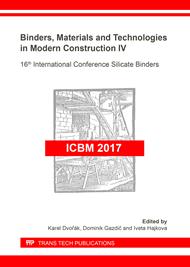[1]
Nizamov R. Multifunctional fillers for the chloride of the building/construction tracks.Materials, 7 (2006), 68-70.
Google Scholar
[2]
R. Galeev, Abdrakhmanova L. Architectural control of construction materials with application of made wastes/AIP Conference Proceedings, 1698 (2016), 070021.1-070021.8.
DOI: 10.1063/1.4937891
Google Scholar
[3]
Galeyev R., Abdrakhmanova L.A., Nizamov R. Expanded perlite Sand: Features of modification of chloride compositions/news Kgaus, 3 (2016), 166-171.
Google Scholar
[4]
Abdrakhmanova, L.A. Nanomodifikatory for building materials based on linear and netted polymers//construction materials, 7 (2011), 61-63.
Google Scholar
[5]
Galeyev R.R., Abdrachmanova L.A. PVCL polyfunctional Disperse Fillers Based on technogenic Ram materials/high-tech in chemical engineering-2014/Zwenigorod (2014), 256.
Google Scholar
[6]
Ashrapov A.H., Abdrakhmanova los, Nizamov R., Hozin v. G. Study of PVC compositions with carbon nanotubes/scientific Internet Journal of Nanotechnology in Construction, 3 (2011), 13-24.
Google Scholar
[7]
Vladimir Masjurov, S. Attorney, P.G. E.D. Yegorov Lebedev Study of the effects of the fill on the properties of PVC compositions/plastic masses, 2 (2005), 44-45.
Google Scholar
[8]
Hess, W.M. Product performance and Carbon Black Dispersion W.M. Hess, J. Wiedenhaefer//Rubber World, 6 (1982), 15-27.
Google Scholar
[9]
Blake, R. Reinforcement of poly (vinyl chloride) and polystyrene using chlorinated polypropylene grafted carbon nanotubes/R. Blake, J.N. Coleman, Ph. Byrne, J.E. McCarthy, T.S. Perova, W.J. Blau, A. Fonseca, J.B. Nagy, Y. K. Gun'ko//Journal of Materials Chemistry, 16 (2006).
DOI: 10.1039/b612305h
Google Scholar
[10]
Guojian, W. Study of SMA Graft modified MWNT/PVC composite materials/W. Guojian, Q. Zehua, L. Lin, S. Quan, G. Jianlong/Materials Science and Engineering, 472 (2008), 136-139.
DOI: 10.1016/j.msea.2007.03.017
Google Scholar
[11]
Mamunya, Y. Electrical and thermophysical behaviour of PVC-mwcnt nanocomposites/, A. Boudenne, N. Lebovka, L. IBOs, Y. Candau, M. Lisunova//Composites Science and Technology, 9 (2008), 1981-(1988).
DOI: 10.1016/j.compscitech.2007.11.014
Google Scholar
[12]
Bai, C. Nanoscience and Technology/C. Bai, S. Xie, X. Zhu. Solid State Phenomena, 121-123 (2007), 1459-1462.
Google Scholar
[13]
Benderly, D. PVC nanocomposites-nanoclay chemistry and performance/D. Benderly, F. Osorio, L. Wouter//Journal of Vinyl and Additive Technology, 14 (2008), 155-162.
DOI: 10.1002/vnl.20163
Google Scholar
[14]
PVC-Clay nanocomposites: Preparation, thermal and mechanical properties/D. Wang, D. Parlow, Q. Yao, C. A. Wilkie//Journal Vinyl & Additive Technology, 7 (2001), 203-213.
DOI: 10.1002/vnl.10292
Google Scholar
[15]
Whose, C.B. Preparation and characterization of poly (vinyl chloride) calcium carbonate nanocomposites via melt intercalation/C.B. Whose, U.R. Kapadi, D.G. Hundiwale, P.P. Mahulikar//Journal of material science, 44 (2009), 3118-3124.
DOI: 10.1007/s10853-009-3414-y
Google Scholar
[16]
Zeng, X. F Influence of the diameter of CaCO3 particles on the mechanical and rheological properties of PVC composites/X.F. Zeng, W.Y. Wang, G.Q. Wang, J.F. Chen//Journal of material science, 43 (2008), 3505-3509.
DOI: 10.1007/s10853-008-2475-7
Google Scholar
[17]
Guzeev, b. to the structure of PVC-based composition and dimensional calcium carbonate/Vladimir Guzeev, L.A. Schulatkina, ETC., L.I. Batueva///plastic mass, 8 (2007), 14-17.
Google Scholar
[18]
Zhang, L. Mechanical Properties of PVC/nano-CaCO3 composites/L. Zhang, X. Chen, C. Mahulikar//Journal of material science, 44 (2009), 3118-3124.
Google Scholar
[19]
Bakar, A.A. Effects of nano-precipitated calcium carbonate about mechanical properties of PVC-U and PVC-uacrylic blend/A.A. Bakar, N.M. Rosli/Journal Teknologi, 34 (2006), 83-93.
DOI: 10.11113/jt.v45.343
Google Scholar
[20]
Afashagova, Z.H. Fractal model for improving plasticity nanocomposites chloride/calcium carbonate/Z.H. Afashagova, G.W. A.H. Goats Malamatov//International Journal of Applied and Fundamental studies, 3 (2009), 38-42.
Google Scholar


